Journal of
eISSN: 2573-2897


Research Article Volume 7 Issue 3
Department of History, Bethune-Cookman University (retired), USA
Correspondence: Fletcher Crowe, Department of History, Bethune-Cookman University (retired), USA
Received: October 17, 2022 | Published: November 22, 2022
Citation: Crowe F. The Voynich Manuscript: Decoded. J His Arch & Anthropol Sci. 2022;7(3):94-131 DOI: 10.15406/jhaas.2022.07.00262
The Voynich Manuscript (VM) is an illustrated codex hand-written in a unique writing system whose pages have been carbon-dated to 1404-1438 CE.1 The document has been studied by numerous cryptographers, but until this time no one has demonstrably deciphered the text. The Voynich Manuscript has been called "The World's Most Mysterious Manuscript" and "The Book Nobody Can Read.” Sections of the manuscript appear to deal with strange plants and flowers, naked women lounging in pools of water, celestial bodies such as stars, the moon and the Sun, and kitchen spices and herbs. This research shows that the strange Voynich symbols code for Arabic. An equivalency table between Arabic letters and the Voynich characters is developed, and large sections of the Voynich text are translated, including pages picturing flowers, stars, spices and women. A 600-word dictionary of Arabic-Voynich-English was developed. Translation reveals that the text deals exclusively with the Cathars, a religious heresy prominent in the south of France in the 12th – 13th centuries. A hypothesis is developed that the patron funding production of the Voynich Manuscript may have been Alfonso V, king of Aragon/Catalonia and, King of Naples.
Keywords: Voynich Manuscript, Medieval Arabic, King Alfonso V, History of Cryptology, Cathars
1Stolte, Daniel. 2011. "Experts determine age of book 'nobody can read.'" PhysOrg. https://phys.org/news/2011-02-experts-age.html, accessed August10, 2019 (February 10, 2011).
The Voynich Manuscript (VM) is an illustrated codex hand-written in a unique writing system whose pages have been carbon-dated to 1404-1438 CE. A sample of the mysterious text can be seen in Figure 1. The codex consists of 245 pages in a small format of 22.5 x 16 cm, with several larger fold-out pages.

Figure 1 Sample Voynich Manuscript Text. Introduction to the Celestial Section, top of Page 67. http://brblzoom.library.yale.edu/viewer/1006194. Courtesy of the Beinecke Rare Books and Manuscripts Library, Yale University.
The document is named after Wilfrid Voynich, an antique book dealer from Poland who presented it publicly in 1910. In 1969, the book was donated to Yale University's Beinecke Rare Book and Manuscript Library, where it is catalogued under call number MS 408.2
The document has been studied by numerous cryptographers, but until this time no one has demonstrably deciphered the text.3,4 The Voynich Manuscript has been called "the world's most mysterious manuscript"5 and "the book nobody can read."6,7 It's been called "an elegant hoax" and a "liturgical manual for the cult of Isis." In 1921, John Manly, a Chaucer scholar, declared it to be the “most mysterious manuscript in the world."8 Gordon Rugg concluded that "The features of Voynichese are inconsistent with any human language,"9 and continued saying that he could not prove that the manuscript was a hoax,10 but that the hypothesis is "indeed feasible."11 After years of study, Robert Brumbaugh ended up calling the Voynich Manuscript "nonsensical."
The celebrated cryptologist William Friedman (1891-1969), who had decrypted the Japanese Imperial Navy "Purple" code in the early days of World War II, devoted considerable work to decode the Voynich manuscript, but Friedman ultimately abandoned his efforts when he failed to make any progress.12 His conclusion was that the text was a series of code words indecipherable without a dictionary of code definitions. Its intractable cipher has made the Voynich a famous case in the history of cryptography, the subject of unending speculation.
The New York Times has called the Voynich Manuscript the "white whale of the code-breaking world." In 1975 Robert Brumbaugh called it "a kind of Mount Everest for cryptanalysts." A statistical analysis of the VM text by Torsten Timm and Andreas Schinner in 2019 supported the so-called “hoax hypothesis,” i.e., interpretation of the text as a set of meaningless strings of unrelated script characters.
Fanciful claims of authorship have been made. Voynich himself, who purchased the manuscript found in the Jesuit Collegio Mondragone in Italy, suggested that it had been written by Roger Bacon, but this conjecture was disproven. In 1976, Robert Brumbaugh published a decoding of the manuscript claiming he had detected a cipher for "Roger Bacon" encrypted as the number 2675221365. Brumbaugh later concluded that the VM was a treatise on the Elixir of Life written in Middle High German that "makes perfect sense."13
Scholars have speculated that the underlying language may have been French, Spanish, Ladino (a dialect of Spanish spoken by Sephardic Jews), Berber, Occitan (the medieval version of proto-French used in what is today's southwest France), Hebrew, Provençal (spoken in medieval southeast France), West German dialects of Flanders from the 12th century, Basque, “medieval Galician”, Yiddish, and even Nahuatl or Mazatec/Otomanguean, an indigenous language of the Indians of Central Mexico!14
In 2019 an article by Gerald Cheshire in Romance Studies claimed that the VM was written in "proto-Latin," an unspecified tongue, a suggestion firmly refuted by Artemij Keidan in 2019.15,16 Leo Levitov declared that the manuscript contains the Isis rituals of Cathars, a religious group in mediaeval southern France.17 He also claimed that it is a gynecology text. None of these guesses furthered the translation of the Voynich.18,19,20
The manuscript’s roughly 245 pages, including fold out pages contain several distinct sections: botanicals21 (multiple detailed drawings of plants), pp. 1-66; a sub-section of plants dealing with herbs and spices; the “balneological” section featuring bathing women, pp. 75 to 84; and the celestial section, pp. 67 to 73, showing zodiacal diagrams with stars centered on zodiac symbols such as Capricorn (the goat), Gemini (the twins), and Libra (a pair of scales).
The entire Voynich Manuscript is available on the internet in high resolution images provided by Yale's Beinecke Rare Book and Manuscript Library. A useful index to these images is provided on the internet at a site managed by René Zandbergen (http://www.voynich.nu/).
The present study decodes the mysterious Voynich script for the first time, and demonstrates that the underlying language of the encrypted text is Arabic (Figure 2).
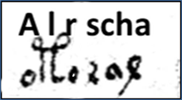
Figure 2 The Name of the Star Al Rescha in VM Script. The VM characters spell out A-L-A-R-S-' (the /l/ is silent).
2Kennedy, Gerry, and Rob Churchill. 2005. The Voynich Manuscript. London: Orion Books Limited.
3Hauer, Bradley and Grzegorz Kondrak. 2016. "Decoding Anagrammed Texts Written in an Unknown Language and Script". Transactions of the Association for Computational Linguistics. 4: 75–86. doi:10.1162/ tacl_a_00084.
4Timm, Torsten and Andreas Schinner. 2019. "A possible generating algorithm of the Voynich manuscript." Published online: 25 May 2019.https://doi.org/ 10.1080/01611194 .2019.1596999.
5Pelling, Nick. 2016. The Curse of the Voynich: The Secret History of the World’s Most Mysterious Manuscript. Surrey, UK: Compelling Press.
6Brumbaugh, Robert S. 1978. The World's Most Mysterious Manuscript. Carbondale: Southern Illinois University Press.
7Schmeh, Klaus. 2011. "The Voynich Manuscript: The Book Nobody Can Read." Skeptical Inquirer Vol. 35, No. 1, pp. 46-51 (January–February 2011).
8Manly, John M. 1921."The Most Mysterious Manuscript in the World.'' Harper's Monthly Magazine,143 ( July?, 1921): 186-97.
9Rugg, Gordon. 2004. "The Mystery of the Voynich Manuscript." Scientific American, Vol. 291, No. 1 (July 2004), 104-109.
10Rugg, Gordon et al. 2016. "Hoaxing statistical features of the Voynich Manuscript." Cryptologia, Volume 41, 2017, Issue 3. Published online: 13 Sep 2016.
11Rugg, Gordon. 2004. "An elegant hoax? A possible solution to the Voynich manuscript." Cryptologia, 28(1) (January): 31 (2004).
12Schinner, Andreas. 2007. ”The Voynich Manuscript: Evidence of the Hoax Hypothesis.” Cryptologia, vol. 31, 95-107. https://doi.org/10.1080/ 0161119060113353. Bauer, Craig. 2012. Editor-in-Chief. Editorial: "100 Years Times Two: Alan Turing and the Voynich Manuscript." Cryptologia. 36, no. 2 (2012) 85-87. Published online: 12 Apr 2012. https://doi.org/10.1080/ 01611194. 2012.660846.
13Hannig, Rainer. 2020. “Voynich-Hebräisch: Der Weg zur Entzifferung”. https://www.rainer-hannig.com/voynich/2020.
14Bax, Stephen. 2014. "A proposed partial decoding of the Voynich script." Unpublished. https://stephenbax.net/wp-content/uploads/2014/01/ Voynich-a-provisional-partial-decoding-BAX.pdf.
15Cheshire, Gerard. 2019. "The Language and Writing System of MS408 (Voynich) Explained." Romance Studies. 37.
16Keidan, Artemij. 2019. "No, the Voynich manuscript has not been deciphered. https://doi.org/10.13140/RG.2.2.22114.56005, Sep 22, 2020.
17Barber, Malcolm. 2000. The Cathars: Dualist Heretics in Languedoc in the High Middle Ages. Harlow, Longman, 2000.
18Davis, Lisa Fagin. 2019. "Why do people keep convincing themselves they’ve solved this medieval mystery?" Washington Post, August 14, 2019.
19Levitov, Leo. 1987. Solution of the Voynich Manuscript: A Liturgical Manual for the Endura Rite of the Cathari Heresy, the Cult of Isis. Laguna Hills, CA: Aegean Park Press.
20Stojko, John.1978. Letters to God's Eye: The Voynich Manuscript for the First Time Deciphered and Translated into English. New York: Vantage Press.
21Taiz, L. and S.L. Taiz. 2011. "The Biological Section of the Voynich Manuscript: A Textbook of Medieval Plant Physiology?" Chronica Horticulturae, vol. 51, no. 2, pp. 19-23.
In famous cases of decoding an unknown text, a cryptanalyst would find some feature of the unknown script that coded for some known text. This is what Jean-François Champollion did when he successfully decoded ancient Egyptian hieroglyphics using the known names of Egyptian pharaohs, and it is the same technique that Alan Turing used during World War II to decode messages of the German High Command.
This project used the same technique. The Voynich Manuscript is filled with drawings of what appear to behundreds of stars, each with a label written in the mysterious Voynich characters. On page 70v2 of the Voynich Manuscript is an illustration of a zodiacal constellation sign, obviously Pisces, with two fish, each with a cord coming from the mouth of the fish (Figure 3).

Figure 3 The Two Fish of Pisces in the Voynich Manuscript, pg. f70v2,http://brbl-zoom.library.yale.edu/viewer/1006200. Note the cords attached to the mouths of the two fish, and the star where the cords are knotted together. Today this star is named Alresha, pronounced "Arrisha." Courtesy of the Beinecke Rare Books and Manuscripts Library, Yale University.
Ancient myth places a star where lines from the fishes’ mouths meet, a star named Al Rescha in Arabic. The Voynich image also shows cords extending from the fishes’ mouths meeting at a star, labeled in the Voynich lettering (Figure 2).
I assumed that this Voynich word spelled out “Al Resha,” an assumption that would yield four possible phonic equivalencies to Arabic letters: A, L, R, S (Figure 2). Most of the visible stars in the night sky carry Arabic names, Arabic versions of Greek names assigned by the astronomer Ptolemy. This connection led me to suspect that the captions of other stars in the Voynich Manuscript might also spell out the Arabic names of stars.
Here was a word from the Voynich text that corresponded to a modern term, yielding script equivalencies to four letters. Not only did this clue provide phonic values of four VM characters, it also confirmed that script was written from left to right. Further, it provided evidence that the other star names pictured may have been labeled with their original Arabic names. In Arabic, nouns frequently begin with the /al/ sound, corresponding to the English word "the." Large numbers of the star names found in VM quires 9 – 12 begin with the same two Voynich script symbols used at the beginning of the word "Alresha." It was, therefore, a logical probability that these were Arabic star names, voiced like celestial terms in English beginning with the /al/ sound — Arabic names that are still in use today, like Kaff (the Palm), and Hamal (the Ram) a quire is eight leaves.
This hypothesis turned out to be correct, for I then had discovered the Arabic name for dozens of stars featured in the Voynich Manuscript. A list of 20 of these star names is provided in Figure 4 below.
This Alresha star label was the key that unlocked transliteration of the Voynich Manuscript. The task to translate further was plain: to choose a short star name with five Voynich symbols in which four of the letters are found in the word "Alresha"; this might allow one to deduce the phonic value of the fifth character.
Thus, slowly and painstakingly, it was possible to build a table of phonic equivalencies between the graceful Voynich script and modern Arabic star names assigned by the International Astronomical Union. Star by star, the Voynich script characters were correlated to Arabic phonetic symbols, and several months of study produced the Arabic names of more than four dozen stars in the VM. Based on these Arabic names, a table representing the phonic values of the VM script symbols was developed (Figure 5). It should be noted that Arabic has 28 consonants while English has only 24 consonants, so there are separate VM characters for each of these 28 consonants. Because Arabic has no O, P, V or X, there are no Voynich equivalencies to these letters. In addition, a table showing the equivalencies between standard English letters and Voynich characters was developed (Figure 6).
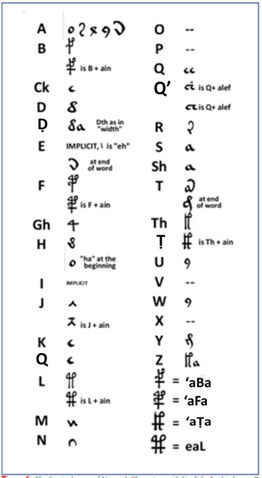
Figure 6 The Equivalences of Voynich Characters with English. Arabic has no P, O, V, or X. In Arabeyes system, /ea/ is written /’a/.
Cross references between English letters and Arabic letters were also developed (Figure 7). Since Arabic does not have an O, P, V or X, there are no Voynich characters for these letters.
Using the phonetic equivalents shown in Figure 5, a dictionary of over 600 Voynich terms was developed. A sample page from this dictionary is shown in Figure 8.
Modern Arabic has no short vowels, but does have diacritical marks to indicate the length of a vowel sound: a tilted bar represents a short /a/, such as /هَبْ/; and a cursive /w/, such as /قّ/, means that the associated letter is doubled in value. Because the Voynich Manuscript was written before diacritical marks were introduced into Arabic, the VM script has no diacritical markings. This can be a problem in translation, because the meaning of some words is clarified by diacritical marks.
Arabic has several characters that English does not have, including the hamza, as in /عالى/. It should be noted that the method of transliterating Arabic into English used in this study is known as Arabeyes, found at https://en.bab.la/dictionary/ab.la, which is somewhat different than the system used in the popular website GoogleTranslate. In the Arabeyes system, the hamza is represented by an apostrophe, while in the GoogleTranslate system it is represented by /ea/.
To test the accuracy of the Voynich script-to-Arabic equivalencies (Figure 7), the Voynich script symbols were employed to determine if they would produce the Arabic names for zodiac signs found in the VM zodiac diagram (Figure 12). This would be a test of twelve words, one for each traditional zodiacal sign: Aries, Taurus, Gemini, and so on. Figure 9 shows the twelve Voynich script words on the zodiac graphic in the Voynich Manuscript. A list of the Modern Arabic names of zodiac signs is shown Figure 7, and the test was to determine if the Voynich equivalencies in Figure 9 could generate these Arabic zodiac terms.

Figure 9 Words on the Voynich Manuscript Zodiac. From the VM graphic, it is impossible to know which sign each of these words represents.
The results of this verification test are shown in Figure 11 and Figure 12. The results of this twelve-word test were encouraging: Three transliterations are identical with modern Arabic (Gemini, Taurus and Leo) and three are quite similar (Aquarius, Sagittarius and Virgo). Two of the zodiac terms were found to be Cathar religious terms; no match could be found for the other four terms. The heretical religious faith of Catharism in the VM is discussed below.
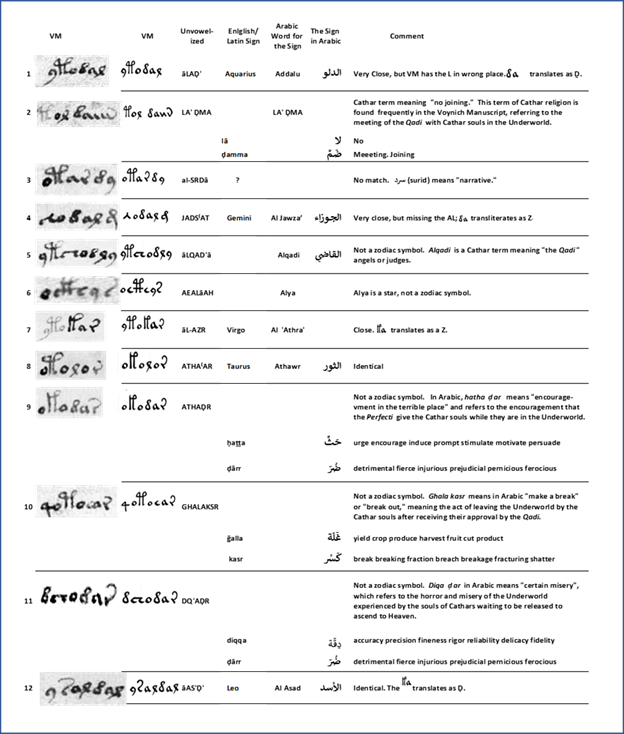
Figure 11 Comparison of Arabic Zodiac Names with Decoded Voynich Manuscript Zodiac Signs. The unvowelized transliteration produced three transliterations identical with modern Arabic, and three very similar to modern usage.
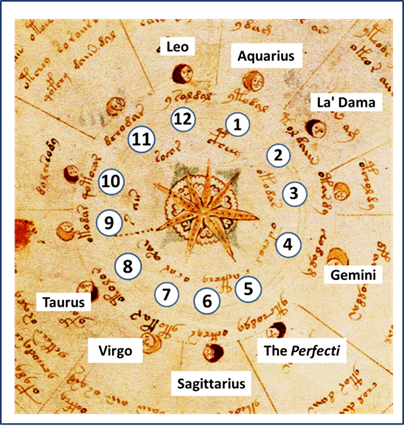
Figure 12 The Zodiac Table found in the Voynich Manuscript. Of the twelve signs, three are identical to modern Arabic (Gemini, Taurus and Leo), and three are very similar (Aquarius, Sagittarius and Virgo). Two others (La Dama and Perfecti) are Cathar religious terms, and the other four are unknown. Base graphic from VM page 67r2; numbers and zodiac names added digitally.
Finding that the translations produced three Arabic words identical to the VM terms and three phonetically similar terms, lent confidence in the accuracy of the equivalencies in the proposed decoding system.
In 2016, the International Astronomical Union formally adopted official names of known stars. The IAU names of most stars visible to the naked eye are simple Western alphabetic voicing of their ancient Arabic names. The next test was to determine if the proposed equivalencies seen in Figure 7 generate the Arabic names of stars.
The Libra star chart appearing on page f72v1 of the Voynich Manuscript (Figure 13) presents 21 figures on the top half of the page: 13 in the Outer Band, and eight in the Inner Band. The Outer Band stars are numbered below in Figure 14. Of these 13 stars, the proposed translation technique generated nine star names identical with their ancient Arabic names, and three others that are almost identical. Ten of these names are spelled in the modern way, but two, Alya and Heka, are spelled in a manner used in the fifteenth century. (The star known as Alya today is spelled in VM in the ancient form of "Alga"; and the star known today as Heka is spelled in the antique manner "al-Haqʿah"). Of these stars, five omit the optional prefix /al/, meaning "the," which appears to have been done to squeeze the name into a cramped space.
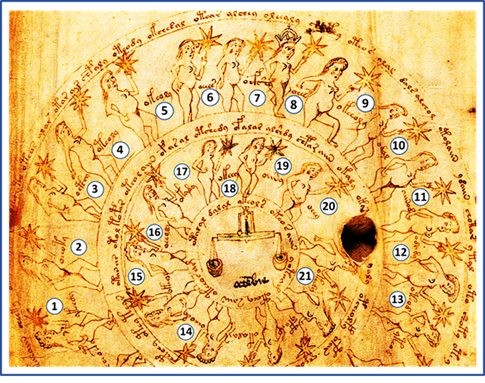
Figure 13 The Top Half of the Voynich Manuscript Libra Star Chart, Page 72v1. Stars 1-13 are in the Outer Band, and Stars 14-21 are in the Inner Band. The 21 figures on the top half of the page are numbered digitally. This study identifies the Arabic names of 12 of these numbered stars. Only stars 2, 7, 13, 14 and 19 are visible during Libra (Oct. 30 – Nov. 23) in the Northern Hemisphere. http://brbl-zoom.library.yale.edu/viewer/1006205, VM pg. 72v1. Courtesy of the Beinecke Rare Books and Manuscripts Library, Yale University.

Figure 14 The 13 VM Star Names of the Libra Diagram, Outer Band page f72v1. Nine star names are identical with their ancient Arabic names, and three others that are almost identical. The remainder are common terms from the Cathar religion.
The proposed decoding technique (Figure 7) had generated the names of 12 stars of the Libra star chart on VM page 72v1, identical or almost identical with modern Arabic star names. These results suggested that the proposed decoding table was a reliable method to use in translating other sections of the VM (Figure 15).
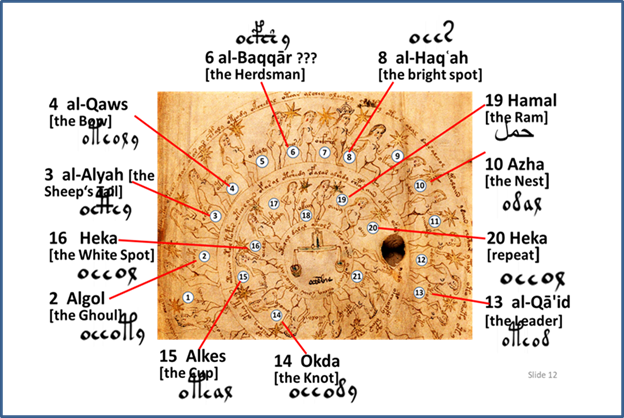
Figure 15 Twelve Stars with Arabic Names in the Top Half of the Libra Zodiac Page of the Voynich Manuscript, pg. 72v1. These VM star names are either identical to, or almost identical to, modern Arabic names. Courtesy Beinekie Rare Books and Manuscripts Library, Yale University. http://brbl-zoom.library.yale.edu/viewer/ 1006205. Numbers added digitally by author.
Successful translation of the VM zodiac and translation of the star names on page 72v1 suggested that the proposed decoding table was a reliable method to use in translating other sections of the VM. Therefore, this decoding table was used to translate pages featuring colorful flowers,22 pages filled with celestial objects like stars and the moon, and pages featuring drawings of spices. Regardless of the page, all text in the Voynich Manuscript was found to describe features of the Cathar religion, a heretical faith centered in the south of France in the twelfth and thirteenth centuries.23
One of these translated pages is f2r, which displays three yellow flowers (Figure 16) and seven lines in the Voynich characters. This selection, like all text in the Voynich Manuscript, features Cathar souls imprisoned in the Underworld, waiting to be rescued by a Qadi and to ascend to heaven.24 The word Qadi is an Arabic and Spanish word meaning “religious judge” and is used in the Voynich Manuscript to mean a spirit or angel that “rescues” Cathar soul0073 imprisoned in the Underworld. More information on the Qadi judges is provided beginning on page 115. In English, these seven lines read:
Line 1 Although buried and [facing] death, the Cathar (souls) are joined [by the Qadi] and agree to accept any mercy, and the waiting souls fly off to live again.
Line 2 The Cathar [souls] are hanging on in their hidden place down below in the Underworld.
Line 3 The [Cathars] hidden in the Underworld are released from the Underworld. They experience mercy and are excited.
Line 4 The Cathars being called are absolved from death. They follow the call and receive mercy.
Line 5 The [Qadi] join and meet with some of the waiting Cathar [souls] and immediately they leave the Underworld for the light.
Line 6 The [Cathar souls] warmly welcome the call from their guardian and have complete confidence they will be released.
Line 7 The Cathar [souls] in the Underworld join [the Qadi] and meet the light.
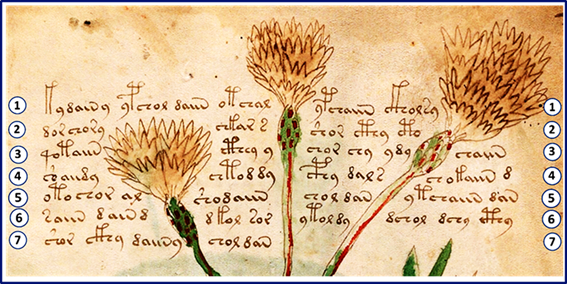
Figure 16 The Seven Lines of the Yellow Flowers Page, page f2r. http://brbl-zoom.library.yale.edu/viewer/1006078, courtesy of the Beineke Rare Books Library, Yale University. Line numbers added digitally for clarity.
How these seven phrases were translated is shown in Table 1 below.
All these lines describe the plight of Cathar souls held in the Underworld after death; the treatment of Catharism in the Voynich is described in detail below beginning on page 55. Like the text of the Yellow Flowers page, the text of the Blue Flowers and the Red Flowers pages of the Voynich Manuscript contain only tenets of the Cathar faith and not a description of the plant interlaced with the text.
The Red Flowers Page: Just as the text of the Yellow Flowers page has nothing to do with plants or flowers, the text of the Red Flowers page (VM page 116v) also has nothing at all to do with botanicals and simply repeats the same tropes about Catharism as are seen in all the other pages.
The first 13 lines of the red Flowers page are seen in Figure 17. These 13 lines are translated as follows:

Figure 17 The Top Half of the Red Flowers Page, VM pg 116v. First 13 lines; line numbers added digitally.
How these lines were translated is shown in Table 3 below.
Celestial Pages: A number of pages of the Voynich Manuscript display illustrations of what appear to be celestial objects like stars, the moon and the sun. One of the 12 Celestial pages of the Voynich Manuscript, page f67v1, is shown in Figure 18. Like the text on the Yellow Flowers page, translation of the text on this page reveals that the page contains only more tenets of Catharism and has nothing whatsoever to do with celestial bodies.

Figure 18 Celestial Page, Page f67v1 of the Voynich Manuscript. Phrase numbers added digitally for reference. Courtesy of the Beinecke Rare Books and Manuscripts Library, Yale University. This page provides dogma of the Cathar religion and no information whatsoever about celestial bodies.
The center of this graphic on page f67v1 appears to depict an illustration of the sun with 17 phrases radiating out from the center of the drawing. However, these 17 phrases do not provide celestial information such as the names of stars, the relative magnitude of the stars, or the constellation in which they are found. On the contrary, each of these 17 radial phrases reiterates only beliefs of the Cathar church. In English, these 17 radial phrases read as follows:
How these phrases were translated into English is shown in Table 2.
Spices Pages: In addition to the phantasmagorical plants featured on the first 57 pages of the Voynich Manuscript and the “celestial” pages, page 88r of the Voynich Manuscript displays a richly illustrated drawing of what appears to be foodstuffs (Figure 19). Confirming the equivalencies, the text on that page was shown to state that the page concerns “fuh”, Arabic for "herbs" [فوه], and food for “katha”, i.e. Cathars. The illustration shows no meats from slaughtered animals, only vegetables, which is consistent with the Cathar prohibition against eating meat.
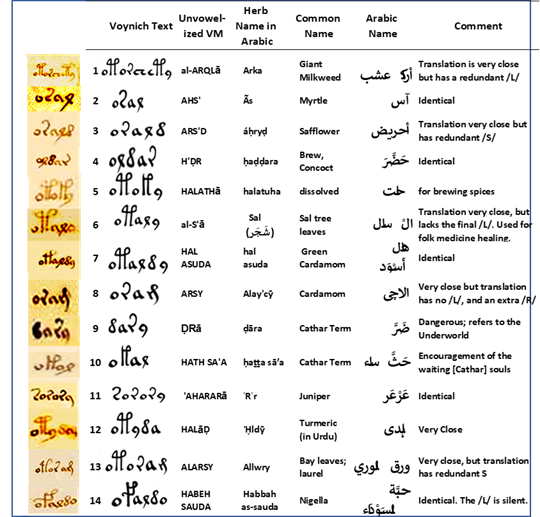
Figure 19 Spices Illustrated on Page 88r of the Voynich Manuscript. Of these 14, six Voynich names are identical with the Arabic name for the spice and five others are quite close; and the remaining three are related. Translations by the author. Arabic spice names from: http://Gernot-katzers-spice-pages.com/engl/spice_Arabic.html
The names of the 14 plants labelled on page 88r were transliterated using the equivalencies table, Figure 7, leading to an identical match for six of the l4 plants, and a very close match for five others (Figure 19). In each case, the pictured plant was a well-known cooking spice, including mustard, myrtle, cardamom and turmeric.
Twelve of these spices are pictured in Figure 20: Plant 1: Giant Milkweed; Plant 2: Myrtle; Plant 3: Safflower; the label of Plant 4 means “to brew”; the label of Plant 5 means “dissolved”; Plant 6: Sal Tree Leaves (for folk medicine); Plant 7: Green Cardamom; Plant 8: Cardamom; the label of Plant 9 means “dangerous”; the label of Plant 10 means “encouragement for Cathar souls”; Plant 11: Juniper; and Plant 12: Turmeric.
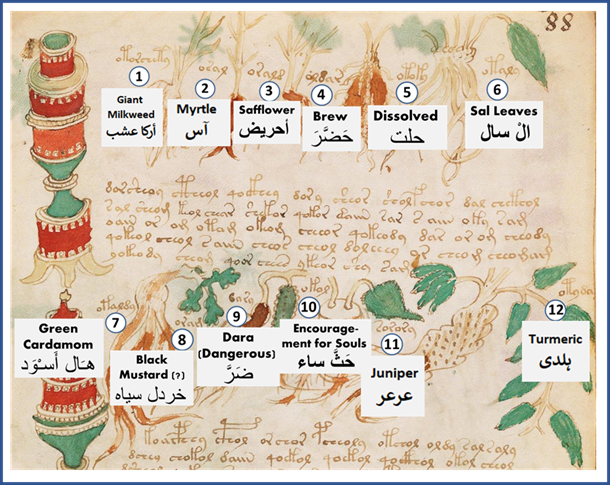
Figure 20 Twelve Spices in the Voynich Manuscript, page 88r. Labels by the author. Graphic courtesy of the Beinecke Rare Books and Manuscripts Library, Yale University. Translations by the author.
The following spices were routinely imported to Europe during the Middle Ages: pepper, cinnamon, cloves, nutmeg, ginger, saffron, cardamom, coriander, cumin, garlic, turmeric, mace, anise, caraway and mustard. Five of the spices illustrated on page 88r of the Voynich Manuscript are included in this list of popular medieval spices: turmeric, cardamom, saffron, ginger, and mustard.25 Cathars were reputed to be trusted healers, so many of these spices and herbs may have been used for folk medicine and healing potions, particularly sal tree leaves.26
22Velinska, E. 2013. "The Voynich manuscript: Plant ID List." Accessed August 3, 2019: http://ellievelinska.blogspot.co.uk/2013/07/thevoynich-manuscript-plant-id-list.html.
23Moore, Robert I. 2012. The War on Heresy: Faith and Power in Medieval Europe. Cambridge MA: Belknap Press.
24Masud, Muhammad Khalid, Rudolph Peters and David S. Powers (eds.). 2006. Dispensing Justice in Islam: Qadis and Their Judgments . Leiden, Netherlands: Brill.
25Duvernoy, Jean. 1994. „La nourriture en Languedoc à l’époque cathare“, in: Jean Duvernoy. Cathares, vaudois et béguins, dissidents du pays d’Oc. Toulouse: Privat 1994, 229-236. See also: Freedman, Paul (ed.). 2007. Food: The History of Taste. Berkley CA: Univ. of California Press.
26Wakefield, Walter. 1982. “Heretics as Physicians in the thirteenth century.” Speculum 57 (1982), 328-332.
Translation of the Voynich Manuscript reveals the codex is a consistent profession of the Cathar faith.27 Cathars were heretics strongly opposed to the teachings of the Catholic Church, whose religion flourished in the twelfth and thirteenth and fourteenth centuries in Languedoc,28 today’s southern France (see Figure 21).29 The Cathars of Languedoc were devastated in a vicious war known as the Albigensian Crusade from 1209-1244 which essentially destroyed their religious practices, and the last leader of the heresy died in 1321.30
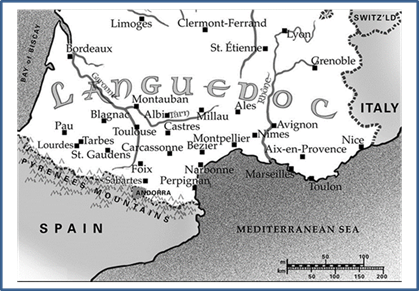
Figure 21 Medieval Cathar sites in Languedoc, the South of France. Ermessendis, the countess of Foix, was a leader of the Cathars in Languedoc.
Some contemporary scholars have dismissed the Cathar movement as a disorganized religious faith, noting that the word “Cathar” does not occur in accepted historical references. This study has discovered, however, that the VM word for “Cathar” occurs frequently throughout the Voynich Manuscript (including pages 88, 84r and the Rosettes foldout page). Catharism had no orthodoxy or catechism like the Roman catholic church, so its teachings can seem vague and variable. Most contemporary records were set down not by Cathars themselves, but by their enemies in the Inquisition.31 The last Cathar religious leader, William Bélibaste, were captured and burned at the stake in 1321, and the Voynich manuscript has been carbon-dated to about 1420-1430, about 100 years later. Thus, the Voynich provides an almost contemporary description of Cathar practices that does not exist in any other existing document. This study makes an important contribution toward a better understanding of the Cathar faith.
Cathars believed that there were two equally powerful deities, one good, one evil.32 The “good” god, whom they associated with the god of the New Testament, was master of the spiritual world and the human soul. The material world, and all things in it, was the realm of the “evil” god, associated with the god of the Old Testament.
The Cathar heresy was particularly prominent among the nobility of Languedoc:33 In 1279, a general amnesty was announced to encourage Cathars to give themselves up without recriminations. Out of the first 195 people to be listed in the amnesty, 23 per cent were “demonstrably gentlefolk and patricians,” while only 15 per cent were crafts-and-trades persons.34
The most devout among the Cathar dualists therefore rejected sex and parenthood because this equated to bringing another poor soul into the world of torment. They also refrained from eating any meat or other animal products, because they were created through reproduction. These kinds of beliefs had existed since before the foundation of the Christian Church in the religion of Zoroastrianism. There is an intellectual tradition linking the Cathars to the Gnostics and Manicheans of the early Christian Church, who applied elements of the dualist35 Zoroastrian teachings to the Christian message.36,37 Evidence showing how these beliefs were transmitted to Western Europe is somewhat unclear, but there is enough material to suggest that the Bogomils, a dualist sect originating in what is now Bulgaria, played a significant role in bringing the dualist doctrine westwards.38,39 Many historians believe that Cathar beliefs derived from the Balkans, and the dualist religion known as Bogomilism, which itself drew on both Gnosticism and Manicheism.
In contrast with the teachings of the traditional Christian Church, the Cathars rejected the Old Testament, apart from the Ten Commandments. They did accept large parts of the New Testament, though they denied the humanity, death and resurrection of Jesus Christ. Identified for the first time in Western Europe in the Rhine area in about 1140, the early Cathars presented themselves as itinerant preachers, practicing an evangelical model of life that proclaimed voluntary poverty and the condemnation of the ostentation of the Catholic hierarchy. They preached against the sumptuous wealth of the Catholic hierarchy, the moral depravity of the clergy, and the accumulation of temporalities at the hands of ecclesiastical entities.
Cathars were found throughout Latin Christendom in the 12th to the 14th centuries. They were most deeply entrenched in Languedoc (today's southern France) and northern Italy (Figure 22).40 The faith is sometimes called Albigensianism, but this is a misnomer, associating a broad faith with a single walled city, Albi, which was among the first cities to be sacked at the beginning of the Albigensian Crusade of 1209-1244 CE.
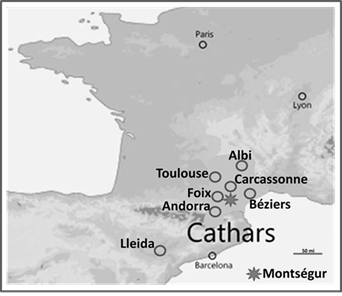
Figure 22 The Cathar Region of Languedoc. Catharism flourished in the eleventh and twelfth and thirteenth centuries as a heresy in Languedoc, today's southern France near Toulouse and Carcassonne. Albi was a target of the Albigensian Crusade. Béziers, the first city to be attacked in the Albigensian Crusade, is near the coast, 69 km northeast of Carcassonne; and Mountségur, the site of the last bastion of Cathar defense, is 51 km southwest of Carcassonne.
The majority of Cathars were weavers and tailors, most often illiterate. The great industry of the Languedoc Cathars was textiles.41 The wool of Languedoc was considered excellent; nine cities and 52 towns were devoted to weaving, and some to dying, a cottage industry.42 Many of the weaving workshops were composed of Cathars or those friendly to Cathars, and often the proprietor was himself or herself Cathar, operated like a Cathar community. The Cathar workshops managed by a Perfect or a Believer attracted large numbers of workers that could be called a convent or a commune, “une maison de Parfaites,” which were corporations. Cathars often ‘publicly held’ their own single-sex houses, sometimes procured or supported by a family member. Sermons and gatherings of believers were held in these buildings. After the advent of the crusade the Cathars were forced to live less openly.
Cathars were philosophically distinct from the Catholic Church of Rome which, according Cathar belief, had betrayed the original doctrine of Jesus and His Apostles. The Cathars saw themselves as a “stream of pure (katharos) Christianity preserved from the days of Christ. Proclaiming the Catholic Church as the "Church of Satan," the heretical sect believed that the grotesque beast described in the Book of Revelation was the Catholic Church, which they saw as a “religion of wolves.” They denied the Catholic sacraments of Holy Communion, baptism and marriage. Understandably, doctrines of the Catholic Church were strongly opposed to the Cathar’s Manichean-Gnostic views.43
The Roman church was determined to root out all heresy as a threat to its dominance.44 This insistence resulted in Pope Innocent III’s Albigensian Crusade. By papal orders, Cathar books and documents of doctrine were routinely burned. The Fourth Lateran Council in 1215 ordered that all heretics who refused to recant should be handed over to secular authorities for punishment, and their belongings confiscated.45
Nearly every account of Cathar lives and doctrines comes from testimonies passed to us by their enemies: investigations by Dominican inquisitors, “confessions” of tortured Cathars, informers, accounts from the brutal northern Crusaders sacking villages and towns, and — worst of all — the painstaking Inquisition, specifically created by Rome to pursue hidden Cathars.46 So our understanding of Catharism is limited. We know more about their pain than their beliefs.
Knowledge of the Cathar faith today is spotty. Cathar books were burned, and all books written in the language of Languedoc and translations of the Bible were prohibited. For this reason, Cathar books cannot be found today.
The Voynich Manuscript reads as a passionate expression of Cathar hopes and beliefs. Catharism was said to have died out over a century before 1430. Did a moneyed lord create the Voynich as a gesture of good will extended to potential allies across the Adriatic? Or was the Voynich a secret profession of faith between one clandestine Cathar commune and another? Some insist the Cathars were simple villagers, uneducated rural people who were predominantly illiterate. Scholars have found very few contemporary Cathar written records beyond the transcript of interviews conducted by the Inquisition. Given the zeal and ruthlessness of the Inquisition, it is no surprise that their literary footprint hardly exists.
There is one estimate that in the early fifteenth century only one-half of one percent of the French population were literate. But Cathars may have been able to communicate from one Cathar community to another in the Cathar diaspora following their defeat at the Battle of Montségur in 1244.47 A portion of the Cathar ritual has been found in Lyon, France, with wording in both the local vernacular (called Occitan) and in Latin (see Figure 23).48 Evidently a certain segment of the Cathar community could read and write without difficulty – and quite possibly the strange Voynich script may have been used to enable disparate Cathar communities to communicate in secret across the Mediterranean. The writing of the hands that penned the Voynich Manuscript is swift, certain, uniform and confident, implying that the writers themselves may have been quite familiar with the Voynich characters and were used to forming them. Perhaps this implies that the Voynich characters were used in other secret Cathar communications long before the Voynich was ever written.

Figure 23 Rituel provençal. Consolamentum des Malades. Lyon. Bibliothèque municipale de Lyon, fons Adamoli A I. 54, fol. 241. This section is in Occitan.
If Cathars used Voynich script to communicate, the recipients must have been able to decode the underlying Arabic. Arabic-speaking Muslims had occupied Iberia for 600 years before the Voynich Manuscript was written, and Arabic-speaking scholars were widely available in the Crown of Aragon to translate Arabic. The fact that the Voynich Manuscript coded for Arabic does not seem to be a stumbling block to its use.
27Nelli, René, Fernand Niel, and Jean Duvernoy. 1965. Les Cathares. Paris: Editions de Delphes.
28Nelli, René. 1974. Histoire du Languedoc. Paris :Hachette
29Lambert, Malcolm. 1998. The Cathars. Oxford: Oxford University Press.
30Given, James B. 1997. Inquisition and Medieval Society: Power, Discipline, and Resistance in Languedoc. Ithaca: Cornell University Press.
31Brenon, Anne. 2003. «Les dominicains et l’Inquisition» in Anne Brenon (ed). Dissidence chrétienne dans l’Europe médiévale I: Les archipels cathares. Castelnaud la Chapelle: L’Hydre, 265-269.
32Jiménez Sanchez, Pilar. 2003. “Le catharisme: une origine orientale à deux tendances?”, in: Edina Bozóky (ed.), «Bogomiles, Patarins et Cathares Slavica Occitania 16, 207-227.
33Vidal, J. M. 1911. “Esclarmonde of Foix” in Revue de Gascogne, 57. https://gallica.bnf.fr/ark:/12148/bpt6k5742642t/ f58.item.texteImage.
34Hancke, Gwendoline. 2008. «Les femmes nobles languedociennes à l’époque du catharisme », Genre & Histoire [En ligne], 2 | Printemps 2008, mis en ligne le 14 juillet 2008, consulté le 21 mars 2022. URL : http://journals.openedition.org/genrehistoire/318
35Runciman, Steven. 1947. The Medieval Manichee: A Study in the Christian Dualist Heresy. Cambridge: Cambridge University Press. Reprinted by The Viking Press, 1969.
36Arnold, John H. and Peter Biller (trans.). 2016. Heresy and Inquisition in France, 1200-1300: Selected Sources Translated and Annotated. Manchester: Manchester University Press.
37Hagman, Ylva. 1993. “Le catharisme, un néo-manichéisme?”, Heresis 21, 47-59.
38Biget, Jean-Louis. 2003. «Les bons hommes sont-ils les fils des bogomiles? Examen critique d’une idée reçue» in Edina Bozóky (ed.), «Bogomiles, Patarins et Cathares», Slavica Occitania 16, 133-188.
39Hagman, Ylva. 2003. «La cosmogonie de l’ Ecclesia Sclavoniæ et les controverses sur la Charte de Niquinta» in Jean Breuillard, Edina Bozoky et Marie Vrinat-Nikolov (éd.), “Bogomiles, Patarins et Cathares,” Slavica Occitania, 16, 2003, p. 247-258. http://revues.univ-tlse2.fr/slavicaoccitania /index.php?id=657
40Nelli, René. 1995. Les Cathares en Languedoc. Paris: Hachette.
41Kaelber, Lutz. 1997. “Weavers into Heretics?”, 1997. Social Science History 21/1, 111-137.
42Nelli, René. 1969. La Vie Quotidienne des Cathares du Languedoc au XIIIe Siècle. Paris: Hachette.
43Schneider, Michael. 2019. “Bogomils and Cathars.” in G W. Trompf, Gunner B Mikkelsen, Jay Johnston, and Milad Milani (eds.). The Gnostic World. Abingdon, Oxon: Routledge.
44Sackville, Lucy. 2011. Heresy and Heretics in the Thirteenth Century: The Textual Representations. Heresy and Inquisition in the Middle Ages. York: York Medieval Press.
45Frassetto, Michael (ed.) 2006. Heresy and the Persecuting Society in the Middle Ages: Essays on the Work of R. I. Moore. Leiden: Brill.
46Hamilton, Bernard. 1989. The Medieval Inquisition. New York: Holmes & Meier.
47O'Shea, Stephen. 2001. The Perfect Heresy: The Revolutionary Life and Death of the Medieval Cathars. London: Walker & Co.
48 Moore, Robert I. 1994. “Literacy and the Making of Heresy, c. 1000 – c. 1150”, in: Peter Biller and Anne Hudson (eds.), Heresy and Literacy, 1000-1530, (Cambridge Studies in Medieval Literature 23), Cambridge: Cambridge University Press.
Every page of the Voynich Manuscript speaks to the destiny of Cathar souls after death to be confined in the Underworld until they are rescued by a “Qadi,” a spirit that has the power to authorize a soul to ascend to heaven and shine as a star in the night sky.49 The manuscript details the six stages that a Cathar soul experiences in its life after death. This tenet of Cathar theology is missing in the records of Catholic Inquisitors and polemic treatises like those of Rainier Sacconi and Moneta of Cremona, so this discovery adds new depth to the understanding of the Cathar religion.50
The six stages of death and resurrection that are accorded such prominence in the Voynich Manuscript are as follows:
Specifically, these six steps are described as follows:
Stage 1: Death -- The first of the six steps experienced by Cathar souls after death, according the the Voynich Manuscript, is falling through the "hole" called in Arabic a ṣala. (صالة) illustration on VM pg. 66 (Figure 24).
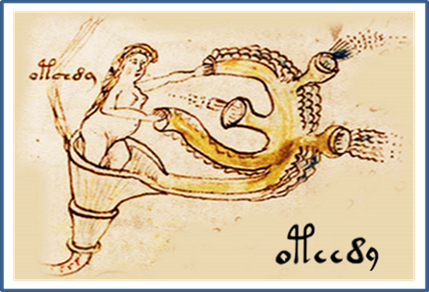
Figure 24 A Qadi Managing the Qana (Passageways). The Voynich word on the drawing spells out “al-qada” (a leader or commander), which means a Cathar religious leader. Word added digitally.
The consolamentum could only be given by Cathar Perfecti, usually in extremis, just before death. (The Perfecti were the most holy Cathar religious leaders; a Perfecta was a female leader, Perfectae plural). A copy of the Gospel of Apostle John, especially important to Cathars, was laid on the initiate's head. The initiating Perfecti – often more than one – lay hands on the shoulders of the dying to absolve the Cathar’s sins. Dying in a purified state enhanced the likelihood of being quickly rescued from the underworld. It was a treasured rite, promising a quick path through the pits of death to rescue and exaltation by Cathar angels to the glory of becoming a star.
Many Believers would receive the consolamentum as death drew near, when the strict ascetic regimen required of a pure soul would be temporally short. Some of those who received the sacrament of the consolamentum upon their deathbeds shunned further food, drinking only cool water. Some exposed themselves to extreme cold, opened their veins, or took poison in order to speed death, so their purified souls could not be tainted in deed or thought in life. This difficult ritual of surrender was called the endura VM pg 66.
Stage 2: Descent to the Underworld -- The souls then proceed down a passageway called a qana (قناة). (Figure 26).

Figure 26 Ten Cathar Spirits in the Underworld Waiting for Rescue. Voynich Manuscript pg. 75v http://brbl-zoom.library.yale.edu/viewer/1006209, courtesy of the Beinecke Rare Books and Manuscripts Library, Yale University. Arabic, Voynich and English captions added digitally.
The second stage of Cathar death is illustrated in Figure 28 where souls descending down a passageway called a qana, the channel or passageway that connects the living world to the Underworld. The Arabic word qana (قناة) means a "channel, canal, conduit, duct, passage or watercourse." The qana would lead to the Underworld, a place called qae, the Arabic word قاء, meaning "bottom" or “bed.” A Qadi managing a network of qana (passageways) is shown in Figure 24.
The caption attached to (Figure 27) repeats the theme of the Qadi redeeming the Cathar souls stranded in the Underworld to release them from their confinement. In English, the Arabic words of the caption read: Here Qadi [angels/judges] encourage [Cathar souls] in the terrifying sorrow of death. The Qadi are said to call them [to overcome] death.

Figure 27 Five Cathar Spirits Descending a Qana to the Underworld. Courtesy of the Beinecke Rare Books and Manuscripts Librdary, Yale University. Translation by the author.
3 Languishing in the Underworld -- The next stage of death for Cathar souls, according to the Voynich, is the perilous wait in the pools of the underworld. They hope the Qadi will judge their souls as fit for moving on, fearing that they must endure yet another reincarnation in the cycle of physical imprisonment if they are not chosen.
In Figure 28, twelve women are shown in a pool (VM page 84r); these are souls of the dead awaiting rescue or reincarnation in the Underworld.
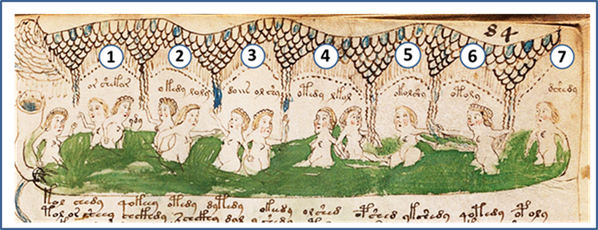
Figure 28 Twelve Cathar Spirits Languishing in the Underworld. The Voynich Manuscript, pg. 84r. http://brbl-zoom.library.yale.edu/ viewer/1006226, accessed June 27, 2019. Courtesy of the Beinecke Rare Books and Manuscripts Library, Yale University. Translation of the seven panels by the author. Numbers added digitally.
The seven captions above the twelve figures describe their situation. These words in the seven panels can be translated as:
How these phrases were translated is shown in Figure 29.
4 Rescue by the Qadi -- The fourth step in the journey of the Cathar souls after death is their rescue by the Qadi, which is illustrated on page 83r of the VM, shown in Figure 30. At the top left of this illustration a Cathar soul rests in a tub labelled [قلس وح] qals ruh ("Trapped Soul" in Arabic). At the top right, a figure in a channel (qana) is labelled [أى أسمى, a' 'asmaa ("Highest Level" in Arabic). Beneath these two captions is a third caption reading أسير ضأ ضياع “captive in death.” and a fourth caption, on the lower right, in the Underworld, labelled ضار أوى, dar 'awaa ("Dangerous Place" in Arabic).
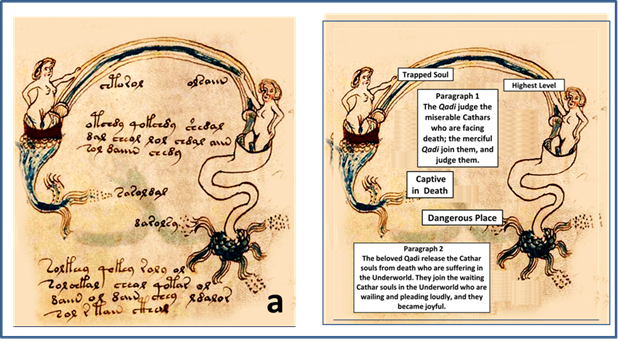
Figure 30 The Underworld Network, Page 83r of the Voynich Manuscript. http://brbl-zoom.library.yale.edu/viewer/1006224. Courtesy of the Beinecke Rare Books and Manuscripts Library, Yale University. Translations by the author.
This illustration also contains two long paragraphs. In English translation, Paragraph 1 in the top half of the graphic reads, “The Qadi judge the miserable Cathars who are facing death; the merciful Qadi join them, and judge them.” And Caption 2 in the lower half of that illustration reads in English, “The beloved, trusted Qadi joined any waiting Cathar souls that were wailing and that were suffering in the Underworld. They picked out the Cathar souls to escape from death which became joyful.”
5 Ascent to the Heavens -- In the fifth step of the afterlife process, Cathar souls are “rescued” by the Qadi and are released to ascend to fardus (the Arabic word for “heaven”). Figure 31 depicts Cathar souls ascending in a spiral to that heaven. The word fardus is shown in Figure 33. Belief that a Qadi will will save a soul is strictly in opposition to Roman Catholic orthodoxy for it is not Jesus who will save Cathar souls, but the rather the Qadi.
The spiral of words curling up into the heavens in Figure 31 depicts the journey of the Cathar souls to the stars. This journey is the apotheosis of Cathar faith: an afterlife as a shining star in heaven. These 28 Voynich words are shown in Figure 32, along with their phonetic transliteration, which codes for Arabic words.

Figure 31 Cathar Souls Ascending to Heaven. The spiral of 26 words represents the Cathar souls sailing to Heaven to become stars in the night sky. http://brbl-zoom.library.yale.edu/viewer/1006231, courtesy of the Beinecke Rate Books and Manuscripts Library, Yale University. Accessed June 28, 2019.
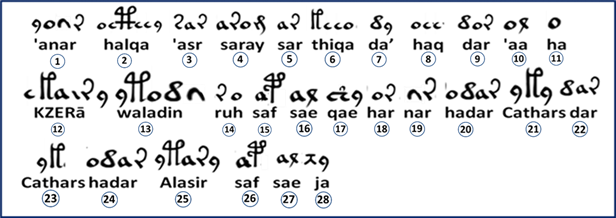
Figure 32 Twenty-eight words SPIRALING into Heaven. http://brbl-zoom.library.yale.edu/viewer/ 1006231, courtesy of the Beinecke Rate Books and Manuscripts Library, Yale University. Accessed June 28, 2019.
These 28 words can be translated into English as the following: “The miserable Cathar souls in terrifying captivity in the Underworld are rightfully released. The confident, overjoyed Cathars arrive in this place [fardus] and are welcomed by the trusted angels. The Cathar souls light up as starlight when they arrive. Here are the other souls who have arrived, released from their captivity.” How these words were translated into English is shown in Table 4 below.
6 Afterlife as a Star -- The final stage in the life after death for Cathars, according to the Voynich Manuscript, is to shine in the night sky as a bright star.51 In Figure 33, 44 Voynich words surround the illustration, numbered 1 through 44. This circle of words reiterates, once again, the theme presented so many times earlier in the manuscript about the Qadi rescuing the Cathar souls from the Underworld and enabling their ascent to Heaven.

Figure 33 Drawing of Heaven in the Voynich Manuscript. Although the drawing appears to depict a medieval castle, the scene is labelled fardus, the Arabic word for "Heaven." The text explains that this is a vision of Cathar Heaven, showing the "souls" (ruh) of alkada (leaders; i.e., Qadi) who have gone to Heaven. The arrow points to the word fardus, Arabic for "heaven" or "paradise." Numbers added digitally. http://brbl-zoom.library.yale.edu/viewer /1006231, courtesy of the Beinecke Rate Books and Manuscripts Library, Yale University. Accessed June 28, 2019.
Translation of the 44 words in Figure 33 has been formed into three groups: words 1–16, words 17-25, and words 26-44. Table 5 shows how these 44 words were translated into English.
Words 1-16: The Qadi encourage and reassure the bereaved Cathar heretics who are moldering down in the Underworld to assess their feelings of their plight and condition relating to this place.
Words 17-25: The Cathars join [the Qadi] who take over the wailing, sorrowful, imprisoned souls and welcome them from harm.
Words 26-44: The Cathars escape from the Underworld and ascend to flout [death] joyfully. The Qadi meet them and welcome them here with their mercy. The [Cathar] captives trust the Qadi to accomplish this: to welcome them and encourage them and cheer them up.
49Fierro, Maribel. 1994. “The Qādī as Ruler” in Saber religioso y poder político en el Islam: actas del Simpsio Internacional, Granada, 15–18 octubre 1991, 71–116. Madrid: Agencia Española de Cooperación Internacional.
50Sackville, Lucy. 2016. "The Textbook Heretic: Moneta of Cremona's Cathars" in Antonio Sennis, John Arnold and Peter Biller (eds.). Cathars in Question. Woodbridge UK: Boydell and Brewer with the Centre for Medieval Studies, University of York.
51Ehrman, Bart. 2020. Heaven and Hell: A History of the Afterlife. New York: Simon & Schuster.
In the Voynich Manuscript, all but a few illustrated figures are the spirits of persons who, when alive, had been women. Moreover, every figure given marks of distinction or seen in commanding situations are female and there are only six illustrations of figures who were obviously men before death.52 The medieval Roman Catholic Church rigidly controlled religious practice in Europe, and nearly all positions of Church leadership were available only to men.53 By contrast, in the Cathar religion, women religious leaders, known as Perfectae, performed evangelical, pastoral, and sacramental functions. Cathar gender-neutrality was considered heretical and inconceivable to the Catholics.54 In Arabic, the word Qadi means "religious judge" or "magistrate," and every figure appearing in the Voynich codex labeled as a Qadi is drawn as a woman.
Women were drawn nude to indicate they were dead, in the Underworld. Figure 34 shows drawings of four figures who surely must have been women when still alive, and each is labeled as a Qadi (or AlQadi). It's noteworthy that in the VM every one of the figures labeled as a Qadi appears to have been a woman during her life on earth. The power to save the souls languishing in the Underworld, souls waiting for authorization to ascend to heaven, is clearly given to female figures, not male figures.

Figure 34 Four Qadi in the Voynich Manuscript. Every Qadi is shown as a woman. In Arabic the word Qadi means "religious judge" or "magistrate" and is used in the VM to mean a Cathar religious leader. Note that every Qadi is shown wearing a head covering, usually extending down the back.
52Brenon, Anne. 2004. Les femmes cathares. Paris: Perrin.
53Arnold, John H. 2013. “Gender and Heresy,” in J. M. Bennett and Ruth Mazo Karras (eds.). The Oxford Handbook of Medieval Women and Gender. Oxford: Oxford University Press, 496-509.
54Roach, Andrew P. and James R. Simpson (eds.). 2020. Heresy and the Making of European Culture: Medieval and Modern Perspectives. Milton Park, Abingdon-on-Thames, Oxfordshire, UK.
After more than a century of unsuccessful attempts to translate the Voynich Manuscript, this study has discovered that the base language of the document is Arabic. The equivalencies table of this study produces the Arabic names of six VM zodiac signs; it also produces the Arabic names of 49 stars and the Arabic name for eight familiar spices.
Limitations – One limitation of this study is that Modern Standard Arabic (MSA) was used in translating the Arabic words of the Voynich Manuscript into English. However, the Voynich was written in the early fifteenth century when medieval Arabic was in use. Consequently scholars of medieval Arabic like Frederico Corriente who was at Saragossa University in Spain, author of A Dictionary of Andalusi Arabic, need to examine the Arabic vocabulary and grammar used in this translation to determine if any translations need revision to be more in line with medieval Arabic terminology.55 The English used in a work like The Canterbury Tales, written by Geoffrey Chaucer at about the same time as the Voynich Manuscript, is often difficult for a modern reader to understand – and the same degree of changes in English over the last 600 years may have occurred in Arabic.
Catharism -- This study confirms that the manuscript deals with the religious beliefs of Cathar heretics who once lived in southern France. Written in a day when the Inquisition had fearsome powers, it is not unexpected that the work was composed in Arabic, for the tenets of a heretical faith had to remain secret on the pain of death.
The Voynich Manuscript reads as a passionate expression of Cathar hopes and beliefs. But Catharism was said to have died out over a century before 1430. Did a moneyed lord create the Voynich as a gesture of good will extended to potential allies across the Adriatic? Or was the Voynich a secret profession of faith between one clandestine Cathar commune and another? Some insist the Cathars were simple villagers, uneducated rural people who were predominantly illiterate. Scholars have found very few contemporary Cathar written records beyond the transcript of interviews conducted by the Inquisition, but a portion of a Cathar ritual was found in Lyon, France (Figure 35). Given the zeal and ruthlessness of the Inquisition, it is no surprise that their literary footprint hardly exists.
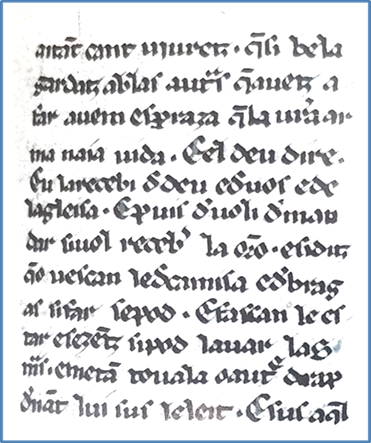
Figure 35 Rituel provençal. Consolamentum des Malades. Lyon. Bibliotèque municipale, fons Adamoli A I. 54, fol. 241. This section in Occitan.
The Voynich Manuscript is an anomaly, a mystery that persists beyond its translation. It is not a theological treatise, not dogma on heaven and hell, salvation, scriptural authority, and the divinity of Christ. Rather, the VM repeats a simplistic narrative of dead souls being rescued from the netherworld, a story that may have been handed down from grandmother to granddaughter, grandfather to grandson over the centuries. Or it may represent the stubborn persistence of a powerful faith that refused to die, but lived its principles beneath the notice of powerful church princes.
Appendix: Alfonso V: Possible Benefactor of the Voynich Manuscript
One of the key questions that have plagued scholars studying the Voynich Manuscript for over a century is who might have paid for its production. Preparation of the Voynich Manuscript must have been a lengthy, costly and even dangerous undertaking. In the fifteenth century, it was standard practice for a wealthy patron to underwrite the costs of such a production. Who, then might have served as the patron for publication of the Voynich Manuscript?
This appendix provides the speculation that the patron responsible for production of the Voynich Manuscript may have been Alfonso V, King of Aragon/Catalonia.
In translating the VM, a number of clues can be found that point to the very real possibility that the benefactor who may have underwritten its production might have been King Alfonso V, the king of Aragon/Catalonia who, later, became Alfonso I King of Naples.56 In the early fifteenth century, the Kingdom of Naples extended over the southern half of the Italian peninsula, and King Alfonso was considered one of the wealthiest and most powerful figures in Renaissance Europe (Figure 36).

Figure 36 The Kingdom of Naples, Bosnia and Venice, 1430. Alfonso V, the King of Aragon and Naples, supported Gjergj Skandebeg, the Lord of Kastrioti, in his wars against Venice and the Ottomans, and enlisted the aid of Bogomils (i.e. Cathars) of Bosnia to support his military objectives. Note the holdings of the Venetian Republic along the Adriatic coast of Dalmatia, plus Bosnia, Serbia, and the Papal States.
Known as Alfonso the Magnanimous, Alfonso ruled as King of Aragon-Catalonia from 1416, and as the King of Naples (as Alfonso I) from 1442 until his death in 1458. The Voynich Manuscript has been carbon-dated to 1404-1438, during his reign. While any identification of Alfonso as the sponsor of the Voynich Manuscript must remain tentative, there is strong evidence that this connection may be correct. As will be seen below:

Figure 37 Alfonso V, Drawing for a Medal, 1448. Courtesy of Alan Ryder, Author of The Kingdom of Naples under Alfonso the Magnanimous (1990). Alfonso V was named as Heir to the Kingdom of Naples.
Alfonso V and His Broad Reach -- Alfonso V was one of the greatest patrons of the early Renaissance. He brought humanism to life in Aragon (today's eastern Spain) and southern Italy. His court was among the most brilliant in Europe. As patron of the arts and the king of Naples, Alfonso the Magnanimous founded the Academy of Naples and was particularly attracted to classical literature (Figure 38). His specific views on Catharism are unrecorded, but it is known that he was no friend of the Pope in Rome; Alfonso had actually supported the Aragonese antipope Benedict XIII, installed at Avignon, just 238 kilometers (148 miles) east of Carcassonne.
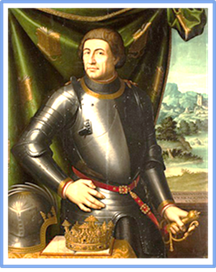
Figure 38 Alfonso V, King of Aragon 1416 – 1458. Ruling the Cathar area of Languedoc in today's southern France, he was a benefactor of the arts.
During the Albigensian Crusade, when hundreds of thousands of Cathars in Languedoc were slaughtered, James I, the King of Aragon, welcomed the Cathar Arnaud I of Castellbò, and the Count of Foix, and his family, who were Cathars, to join his court.63 Castellbò is just south of Andorra, south of Montségur and Carcassonne.64 As a result, Alfonso V may have felt a patrimony of support for Catharism.
One observer, Vespasiano da Bisticci, writing near the end of the fifteenth century, said that the age had given men of learning two benefactors: One was Pope Nicholas V; the other was Alfonso. As the ruler of Languedoc, which was once the home to so many Cathars, he may have been willing – for reasons not readily apparent – to subsidize the document known today as the Voynich Manuscript.
These indications may explain why the VM features the illustration of a tube, conduit, hollow column or canon barrel labeled "Alphonsina" (Figure 39).
Alfonso V and the Heretics of Bosnia -- There are historical-political factors that could have prompted Alfonso V to underwrite the costs of producing the Voynich Manuscript as part of courting military support in the Balkans. The Spanish historian Jordi Ventura (author of El Catarismo en Cataluña [Catharism in Catalonia]), points out that the religion of the Bogomils (an early form of Catharism) was widespread in the western Bosnian Balkans (Figure 40);65,66,67 Alfonso V may have been interested in cultivating Bosnian leaders to support his military objectives in the Adriatic.
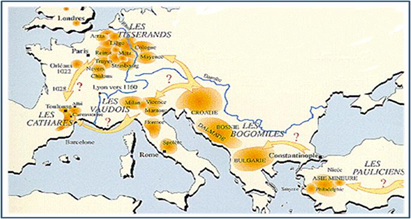
Figure 40 The Spread of Catharism/Bogomilism. Note that the Bogomils were well established in Dalmatia and Bosnia. In his quest to win allies in the Western Balkans, Alfonso V may have been willing to support production of the Voynich Manuscript.
Source: http://s155239215.onlinehome.us/turkic/50Religion/CatharsDatelineEn.htm.
Inquisition authorities say that Catharism ended in Western Europe with the death of William Belibaste in 1321. But there is no doubt that Bogomil dualists, called Patarenes, were very much alive in the Balkans during the rule of Alfonso in the 1420s – 1450s. According to Franjo Sanjek, a professor at the University of Zagreb, in his 2003 article, “Chrétiens-bosniens: un amalgame de catharisme et de valdéisme,” ["Bosnian Christians: An Amalgamation of Catharism and Waldensianism"],68 the Bosnian church was seen as a sister church to the Cathars of Languedoc and maintained regular communication with their co-religionists in the south of France, perhaps by secret script.69
It should be noted that the Voynich text treats only a limited fragment of the Cathar faith. The translated text deals only with the Cathar afterlife and not with its dualistic, Manichaean dogma, or with its overtly heretical views of the Bible and the Roman Church’s self-serving interpretations of the earthly ministry of Jesus of Nazareth.
Alfonso V and the Adriatic -- Alfonso V was named as Heir to the Kingdom of Naples in 1421, a kingdom which at that time ruled the southern half of the Italian peninsula (Figure 41). He wanted Naples – a competitor of powerful Venice – to dominate the lucrative trade routes of the Adriatic Sea. To reach his strategic objectives, he searched for allies across the Adriatic in the Western Balkans. Alfonso's desire to befriend Bogomils in the Balkans, just across the Adriatic, might be sweetened by the gift of a handsomely mounted Cathar book.

Figure 41 The Kingdom of Naples, Bosnia, 1430. Alfonso V, the King of Aragon and Naples, supported Gjergj Skandebeg, the Lord of Kastrioti, in his wars against Venice and the Ottomans, and enlisted the aid of Bogomils (i.e. Cathar-type dualists) of Bosnia to support his military objectives. Note the holdings of the Venetian Republic along the Adriatic coast of Dalmatia, plus Bosnia, Serbia, Venice, and the Papal States.
Alfonso regarded Stephen Thomas, crowned King of Bosnia in 1443, as a potential ally. King Thomas and his wife had both been raised in the Bosnian Church, and were grounded in Bogomil/Cathar dogma. Cathar refugees – known as Bogomils or Patarenes–had come to Bosnia in the early 13th century, and the dualism of Catharism did not die out there until the Ottoman conquest of 1463. Stephen Runciman in The Medieval Manichee, notes that vast regions of Bosnia, including the wealthy Srebrenica district with its silver mines and the district of `Hum (today’s Herzegovina), were solidly Patarene in 1322. Given the strength of Catharism in Bosnia and the desire of Alfonso V to control the Adriatic, a lavish gesture to win over King Thomas as an ally, might have seemed a justified expense.
For Alfonso to generate closer ties with Bosnia, he would have had to establish friendly connections with Stjepan Vukčič, the Grand Duke of Bosnia, who held that position 1435–1466.70 Vukčić was the most powerful Bosnian nobleman, with a career that spanned the reign of three Bosnian kings prior to that country falling under control of the Ottomans in 1463. Vukčič held Hum (Herzogovina) near the strategic Adriatic port of Ragusa (Dubrovnik) which could counter the hegemony of Venice in that sea.
Born in 1404, Vukčić was a leader of the Bosnian Church, which was considered a heretical dualist church affiliated with the Cathars of Languedoc. He grew up as a prominent member of one of the triumvirate of the three great families of Bosnia that, according to John Fine in his book The Late Medieval Balkans: A Critical Survey from the Late Twelfth Century to the Ottoman Conquest were “practically calling all the shots, including steering foreign policy.”71,72
Stjepan Vukćić was a leading supporter of the Bosnian Church to which his father Ostoja had adhered and was one of the Church’s leaders in the 1430s and the 1440s. Another leader of the Bosnia Church, Gost Radin, was more or less his foreign secretary, and resided at his court. Hungary, the threatening power to the north of Bosnia, had given the king of Bosnia the gift of a very fine robe, and it would make sense for Alfonso, who wanted to strengthen ties with Bosnia, to give Vukćić a fitting gift too. And what could be more fitting than a lavishly illustrated book that showed affinity and respect for the heretics of the Bosnian Church? Stefan remained in the bosom of the Bosnian Church as long as he lived.
Although the Voynich Manuscript appears to be a compendium of Catharism (and therefore the heretical theology of the Bosnian Church), in fact the VM simply repeats, endlessly, the same simple statement about Cathar Qadi choosing the souls of dead Cathars in the Underworld to release them to journey to heaven. There is no attempt whatsoever in the VM to have the text wrestle with the intricate and arcane points of theological dogma about Catharism that mark the works of scholastic writers such as Moneta of Cremona or Alan of Lille.
This stands to reason: If the Voynich Manuscript was prepared as a symbolic gift to build diplomatic ties with a foreign nation, it did not need to delve into the convoluted and arcane theology of a religious sect that had essentially disappeared from France over a century before.
Carbon-14 dating indicates that the Voynich Manuscript was probably written sometime between 1404 and 1438. In the 1430s Vukčič, fighting alongside his allies the Ottomans, conquered lands along the Adriatic coast at Bar, Zeta (modern Herzegovina), Dubrovnik and Ragusa (Figure 42). The growth of Ottoman dominance along the coast of the Adriatic worried Alfonso – and might have made the king of Naples interested in building friendlier relations with the heretic Vukčič.
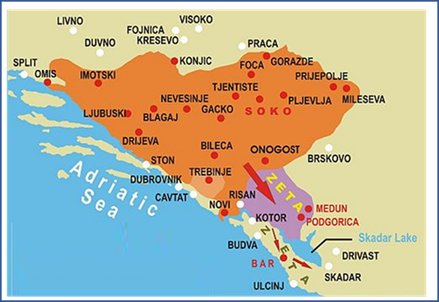
Figure 42 Zeta (Herzogovina). In 1441-1444 Stefan Vukčič, the Duke of Saint Sava, took Zeta, Bar and Dubrovnik (Ragusa), facing Ottomans to the south.
Facing hostile and aggressive Ottomans to the south and seeking support, Stefan Vukčič turned to King Alfonso V of Aragon, and Alfonso made him "Knight of the Virgin." On February 15, 1444, Stefan signed a treaty with the King, becoming Alfonso’s vassal in exchange for Alfonso's help against his enemies—King Thomas, Duke Ivaniš Pavlović and the Republic of Venice. In that same treaty, Stefan promised to pay Alfonso regular tribute instead of paying the Ottoman sultan as he had done until then.
The Eastern Drive of Alfonso V -- Church authorities in France, Spain and Italy maintained that the heresy of Catharism had been exterminated by 1321 with the death of William Belibaste, but the Bosnian church was still quite active in the 1440s. According to Franjo Sanjek, the Bosnian church was seen as a sister church to the Cathars of Languedoc and maintained regular communication with their co-religionists in Occitania.
Many scholars have depicted the Bosnian Church as dualist (Bogomil), but John Fine argues that domestic sources about the Church (Bosnian and Ragusan) do not suggest this. Documents show the Bosnian Church, unlike the Bogomils, accepted an omnipotent God, the Trinity, Church buildings, the cross, the cult of saints, and at least part of the Old Testament. Fine argues that the Bosnian Church emerged primarily to assert local independence and not dualism, and remained essentially mainstream Catholic.
Fine believes, too, that the term “Bosnian Church” is itself misleading. Rather than a standard religious denomination with church buildings used by congregants on a weekly basis, the Bosnian Church, says Fine, was essentially the domain of monks living in remote monasteries, far removed from the daily religious practices of the public. Moreover, according to Fine, the Bosnian Church may not have been truly heretical. Nevertheless, regardless of the findings of modern historians concerning the theology of the Bosnian Church, there is ample evidence that many in the early fifteenth century considered the Bosnian Church as embodying a dualist, heretical doctrine that directly opposed the teachings of the Church of Rome and was aligned with the heretics of Languedoc.
There is solid evidence of continuing contacts between the Cathars of France and the Bosnian dualists reaching back to the twelfth and thirteenth centuries. In 1325 Pope John XXII wrote to Prince Stephen of Bosnia asking him to support the Franciscan Brother Fabian, appointed as inquisitor in his territories. “A great company of heretics,” wrote the Pope, “has come together from many different places to the principality of Bosnia in the confident hope of disseminating their foul error and of remaining there in safety.”
Sanjek also points out that the administrative structure of the kingdom of Bosnia at that time was conducted by officials of the Bosnian church and not by a government agency of the king. It is well documented that Alfonso V, who as a young man had been adopted as heir to the King of Naples, sought to have that kingdom challenge the hegemony of Venice in the Adriatic, and to do this Alfonso sought allies on the east side of the Adriatic.
In his 2019 article “The Eastern Policy of Alfonso V the Magnanimous (of Aragon)” Marijan Premović of the University of Montenegro writes that in the years 1444 and 1445 Stjepan Vukčič was seeking new allies against his Bosnian suzerains since his Ottoman allies were not able to provide any substantial military assistance. In allying with Alfonso, Stjepan sought a close and effective ally in order to oppose the yoke of the Bosnian king. Alfonso responded, but by contrast, the motives of Alfonso seem most likely to have been anti-Venetian rather than anti-Ottoman. In mid-January 1444 Vukčič sent a diplomatic mission to Naples, and in the first half of February, the duke’s envoys arrived in Naples, at the court of Aragon. The duke recognized Alfonso as his “elder brother”, protector and defender, and four years later, in 1448, war between Naples and Venice broke out.
This means that when Alfonso V (or his representatives) tried to establish cordial ties with Bosnia, they had to deal with Bosnian church officials who viewed themselves as closely affiliated with the Cathars of Languedoc. To demonstrate appreciation and affiliation with the Bosnian church, there is every reason to believe that Alfonso would have been interested in underwriting the cost and effort of producing a work like the Voynich Manuscript that described Cathar theology in hundreds of richly illustrated pages.
With the Catholic nobles of Bosnia Alfonso could establish close ties as a like-minded Catholic ruler. But to establish a closer relationship with leaders of the heretical Bosnian Church like Stefan Vukčič and his foreign secretary Gost Radin, Alfonso was forced to operate in secret. Alfonso was most interested in building ties with a powerful national leader in the western Balkans like Stefan Vukčič, and was probably willing to spend the funds required to assemble a lavishly illustrated gift like the Voynich Manuscript. However, he could not afford to do it openly and risk the condemnation of the Pope and Catholic prelates. With the Voynich Manuscript coded in Arabic, the book could remain secret and not incite the ire of the Roman church.
In his biography of Alfonso V, Alan Ryder does not mention contacts between Alfonso and Vukčič, and Ryder does not mention either Bosnia or the gift of the Voynich Manuscript. But Ryder does mention Alfonso’s interest in challenging Venice for domination of the Adriatic, and his efforts to challenge Genoa in the Tyrrhenian Sea west of Naples.73 If, as I suspect, Alfonso sponsored development of the VM, the initiative with Bosnian heretics must have been completely secret, hidden from the ever-watchful eye of the Catholic Church.
Still, Alfonso himself may have been personally opposed to heretics. This may be seen in a letter Alfonso sent to the King of Navarre on behalf of the Count of Caltabellota who had built a galley for the crusading fleet in the arsenal of Naples. Alfonso’s letter asks the regent in Aragon to grant a pardon for any crime to all who enlisted for service in the count’s galley, “excepting only traitors, heretics, sodomites, and coiners.”
Although Catholic authorities held that the heretics of Occitania had died out by 1321 with the death of William Belibaste, there is evidence that the dualist heresy continued in force in Bosnia all through the life of Alfonso, who died in 1458. Around 1460 Pope Pius II referred, in French, to the Bosnian Christians dismissively as “those Manichean heretics who have their monasteries in remote valleys up in the mountains.”
What is significant in considering Alfonso V as the possible patron of the Voynich is the specific focus of Cathar belief that seems tailored to a special audience: women. The pages of the Voynich Manuscript are filled with drawings of spirits who are drawn to look like women when alive. One supposition to explain that would be that the Voynich was developed as a gift for a group of women near death, perhaps aging and infirm Cathar women. Special facilities for older Cathar women were known to exist in Languedoc, and similar houses for older Bogomil women are also recorded. Was the Voynich a gift to one of these women’s hospice houses, perhaps one tending to family members of important Bosnians? Franjo Sanjek notes that the monasteries of the heretical Bosnian Church were “double monasteries,” meaning that both men and women resided there.
Could the VM have been targeted to women members of the heretical, dualist Bosnian Church? The Voynich Manuscript is filled with hundreds of drawings of the spirits of dead Cathars – all of whom appear to have been women when alive. Is it possible that whoever planned the Voynich codex may have intended for it to have a special appeal to women, or certain targeted women. In fact, the wife of King Thomas, Catherine (Katarina), was a “Krstjanka” (a female member of the Bosnian Church) and that might have entered into the decision to prepare the manuscript (Figure 43,Figure 44).
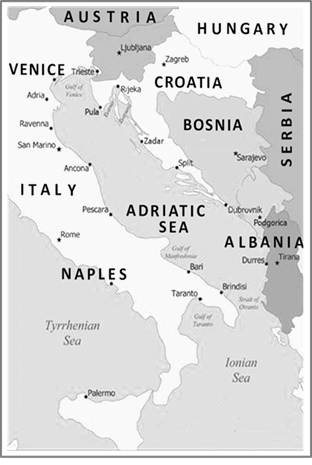
Figure 43 The Modern Adriatic Region of the Western Balkans. In 1421 Alfonso V, the King of Aragon, was named as Heir to the Kingdom of Naples, and in 1443 was crowned as King of Naples. Struggling with the Republic of Venice for hegemony in the Adriatic Sea, Alfonso sought out potential allies among the patarenes [i.e. Cathar-type dualists] of Bosnia. He also supported Gjergj [George] Skanderbeg of Albania against the Ottoman Turks. Note Dubrovnik (formerly called Ragusa).

Figure 44 Bosnia in 1422. In 1422 Bosnia had a very unstable government under King Tvrtko II, and was threatened by Hungary and Venice to the north, the Despotate of Serbia to the east, and a very aggressive Ottoman Empire to the south. A large share of Bosnians were patarenes, an early form of Catharism, and Alfonso V wanted to extend his support to Bosnia to counter the influence of Venice and the Ottomans in the Adriatic.
Preparation of the Voynich Manuscript was costly, lengthy, and to some extent dangerous. But these expenses may have seemed justified to Alfonso V, as King of Aragon and Heir to the Kingdom of Naples, to subsidize the project as an overture to the Patarenes of Bosnia.
Bosnia at that time was independent, but faced serious threats from Venice in the west, Hungary to the north, the Despotate of Serbia to the east, and the restless Ottoman Empire to the south. The Turks raided Bosnia in the spring of 1424, making it clear to King Tvrtko II of Bosnia that an alliance with Venice would not be tolerated. Venice would not provide Tvrtko protection against the Turks, so he gradually dismantled the alliance he had with them. Mindful of the Turks, he may have been willing to enlist aid from Alfonso V.
After years of pleading for their help, King Tvrtko finally saw Hungarians march into Bosnia in 1434. Tvrtko was a Roman Catholic, but the head of the Bosnian patarino church exerted significant influence on matters of state. A patarino had even served as Tvrtko's adviser in 1428, while the king was presenting himself as a good Catholic. In 1443 Tvrtko II was assassinated and Bosnian lords chose Steven Thomas as his successor. Raised as a patarenes, Thomas turned to Catholicism to enlist the help of Venice and Hungary to fend off the Turks, and the influence of Alfonso diminished.
Alfonso the Magnanimous also had a great ally in Albania named Jorge Scanderbeg, who was resisting Ottoman encroachment from the south. In 1451 Alfonso created an alliance that would make Albania a virtual vassal of Naples. Scanderbeg ceded the castle and city of Croia in Albania (modern day Kruja) with all its belongings, to the KING of Naples, and recognized Alfonso’s sovereignty. In 1453, Alfonso sent Catalan troops to guard the city. According to Jordi Ventura, Alfonso placed these troops under the command of Ramon de Ortafá of Perpignan specifically because the commander’s experience with the Cathars of Languedoc would make him welcome among the Bogomils of Croia. Alfonso saw Skanderbeg's resistance as key to ensuring Naples’ maritime dominance over Venice. Possibly, Alfonso may have wanted the same type of arrangement with the heretics of Bosnia.
In 1453 Constantinople fell to the Muslim Ottomans. As a voivode (a military leader) of Bosnia in 1454, Stjepan Vukčić, the Duke of Sant Sabbas, faced a constant threat from the aggressive Ottoman Turks to the south. The country’s defense forces, however, were weakened by division between the two religious factions – Catholics and Cathar/Bogomils – so the duke signed a treaty with Alfonso V that promised support against Turkish domination.
Despite Alfonso’s strategic initiatives, his dreams for a grand Adriatic alliance had no lasting effect. The Ottomans conquered Constantinople in 1453, and ten years later, in 1463, conquered Bosnia. Alfonso himself died in 1458. The province of Bosnia eventually became predominantly Islamic; and memories of devotion to ancient Christian heresies faded away. But during Alfonso’s quest to win over allies in Bosnia he could have been willing to subsidize the production of an elaborate statement of belief for Patarenes/Cathars.
Alfonso V clearly wanted to challenge the lucrative dominance of Venice in the Adriatic and may have thought that a contribution showing ties to the heretics of Languedoc might further that initiative. But there were dynastic considerations as well. As a young man Alfonso V had been adopted by the Angevin monarch of the Kingdom of Naples, so Alfonso was, in light of this adoption, an Angevin (i.e. of the royal house of Anjou in France that ruled England-France for many years). At that time the monarchs of Bosnia were emotionally close to the Angevins of France, so it would have been of strategic value for Alfonso V to promote his dynastic ties to the Angevins in his quest to build trade alliances along the eastern shores of the Adriatic. Subsidizing the production of a book honoring the dualist Church of Bosnia leaders could have been a symbolic act of amity.
55Corriente, Frederico. 1977. A Grammatical Sketch of the Spanish Arabic Dialect Bundle. Madrid: Instituto Hispano Árabe de Cultura. See also: Corriente, Federico. 1997. Dictionary of Andalusi Arabic. Leiden: Brill.
56Bisson, Thomas N. 1991. The Medieval Crown of Aragon: A Short History. Oxford: Oxford University Press.
57Gascon-Chopo, Carles. 2015. «Muret, un hito en la sedentarización del catarismo en Cataluña», Monografías de la Sociedad Española de Estudios Medievales, 6, 149-161.
58Butler, Thomas. 2010. «Les ‘chrétiens‘ bosniaques» in Anne Brenon (ed.), 1209-2009: Cathares: Une histoire à pacifier? Portet-sur-Garonne: Loubatières, 109-115.
59Thomas, Paul-Louis. 2003. «L’Église médiévale de Bosnie était-elle dualiste? » in Edina Bozóky (ed.), « Bogomiles, Patarins et Cathares » (Slavica Occitania 16, 113-129.
60García-Arenal, Mercedes and Fernando Rodríguez Mediano. 2017. "Sacred History, Sacred Languages: The Question of Arabic in Early Modern Spain" in Jan Loop, Alastair Hamilton and Charles Burnett (eds.). The Teaching and Learning of Arabic in Early Modern Europe. The History of Oriental Studies, Volume: 3. Leiden: Brill. DOI: https://doi.org/10.1163/ 9789004338623_007, 133–162.
61López Pérez, Maria.1995. La Corona de Aragón y el Magreb en el siglo XIV (1331-1410). Barcelona: CSIC. Institución Milo y Fontanals.
62Haliczer, Steven. 1990. Inquisition and Society in the Kingdom of Valencia, 1478-1834. Berkeley: University of California Press.
63Catlos, Brian A. 2004. The Victors and the Vanquished: Christians and Muslims of Catalonia and Aragon, 1050–1300. Cambridge: Cambridge University Press.
64Graham-Leigh, Elaine. 2005. The Southern French Nobility and the Albigensian Crusade. Woodbridge, Suffolk, England: Boydell Press.
65Obolensky, Dimitri. 1948. The Bogomils: A Study in Balkan Neo-Manichaeism. Cambridge UK: Cambridge University Press
66Ventura, Jordi. 1959-1960. "El Catarismo en Cataluña" Boletin de la Academia de Buenas Letras de Barcelona, Vol. XVIII 1959-1960, 75-168. Available online at https://www.raco.cat/index.php/ BoletinRABL/article/view/196388 [Consulta: 9-12-2020].
67Ventura i Subirats, Jordi. 1960. El Catarismo en Cataluña. [Catharism in Catalonia]. Barelona: Editorial Aedoí. https://fdocument.pub/ document/el-catarismo-en-cataluna.html
68Sanjek, Franjo. “Chrétiens-bosniens: un amalgame de catharisme et de valdéisme,” ["Bosnian Christians: An Amalgamation of Catharism and Waldensianism"],
69Rakova, Snejana. 1992. «Le bogomilisme et l’Église bosniaque“. Heresis 19, 19-29.
70Premović, Marijan. 2019. “The Eastern Policy of Alfonso V the Magnanimous (of Aragon)” Seen in the Light of His Political Relations with the Bosnian Duke-Herzog Stjepan Vukčić Kosača. Australian and New Zealand Association of Medieval and Early Modern Studies, 36, Number 1.
71Fine, John V. A. 1975. The Bosnian Church: A New Interpretation: A Study of the Bosnian Church and its Place in State and Society from the 13th to the 15th Centuries. Boulder: Bosnian Institute.
72John Fine. 1987. The Late Medieval Balkans: A Critical Survey from the Late Twelfth Century to the Ottoman Conquest. Ann Arbor: University of Michigan Press, 1987. https://archive.org/details/ latemedievalbalk00fine/page/146/mode/2up
73Ryder, Alan. 1990. Alfonso the Magnanimous: King of Aragon, Naples, and Sicily, 1396-1458. Oxford UK: Clarendon Press.
The author declares there are no conflicts of interest.
None.
The author gratefully expresses his most sincerely appreciation for the tremendous help and assistance he received in preparing this study from Jan Adkins who edited the manuscript, and from Mirvat Jamal original-ly from Lebanon, and Dr. Esam Alhadi, originally from Sudan, who guided my Arabic translations.

©2022 Crowe. This is an open access article distributed under the terms of the, which permits unrestricted use, distribution, and build upon your work non-commercially.